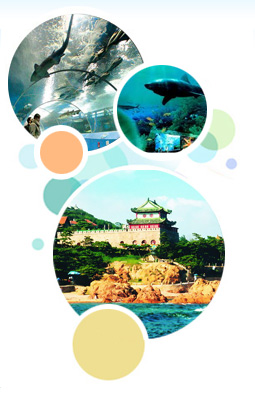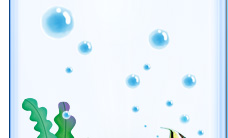Qingdao Aquarium ,used to be called Qingdao Marine Science and Technology Museum or Qingdao Marine Product Museum, was founded by the famous educator, revolutionary and politician Mr. Cai Yuanpei and other cultural pioneers. It was the first aquarium designed and constructed by the Chinese citizens, opening on May 8, 1932. It is also the anchorage of modern marine scientific research and the origin of marine science education in China. After 90 years of development, Qingdao Aquarium has developed into a modern science museum complex of nearly 20,000 square meters with a large-scale underground submarine landscape and five theme pavilions, including Fantasy Jellyfish Palace, Marine Biology Museum, Seal Museum, Freshwater Biology Museum and Whale Museum. In addition to being one of the biggest marine museums, Qingdao Aquarium has a wide range of exhibition categories, an extensive propaganda and education system, and is an iconic historical architecture and famous tourism service provider in Qingdao, and also is the national science education base, national youth science and technology education base and national marine awareness education base in China.
In recent years, Qingdao Aquarium has focused on strengthening its capacity for scientific research and science popularization, and it has made great efforts to promote the modernization and evolution of science popularization in the new era. It has taken the leading position in the studies on the reproduction of seals and jellyfish, the production and classification of marine specimens, and the popularization of marine science education. In order to actively fulfills its social obligations, Qingdao Aquarium has successively initiated and established a number of public welfare platforms for science popularization, such as the Aquarium Committee of the Chinese Association of Natural Museums, the Marine Science Popularization Alliance of Five Cities in Shandong Province, Qingdao Marine Science Popularization Alliance, Qingdao Science Popularization Venue Association, and Qingdao Science and Technology Volunteers Association. These platforms have generated positive social benefits by encouraging the exchange of science popularization resources, the improvement of science popularization skills and the updating science popularization services. They have played an important role in the execution of the Maritime Power Strategy, the improvement of the scientific quality of the whole people, the concentration of construction of "Six Cities", and the acceleration of the construction of a new era of socialist modern international metropolis.
The Fantastic Jellyfish Palace (Qingdao Aquarium)
With a history spanning more than 90 years, Qingdao Aquarium was constructed in 1931, finished and formally opened in May, 1932. Qingdao Aquarium has experienced several large-scale renovations over the years. The exhibition content has changed from sea fish in Yellow Sea and Bohai, to coral reef fish, and finally coelenterates (jellyfish). The exhibition means have also changed from the original natural temperature, to artificial temperature control and advanced life support system, until the current " Fantastic Jellyfish Palace" with contemporary exhibition tachniques. Due to the ongoing renovation and innovation, the level of Qingdao Aquarium’s breeding and research has advanced significantly. The Fantastic Jellyfish Palace is the first professional jellyfish exhibition hall in mainland China. In addition to displays jellyfish in a variety of forms and colors, it also establishes a jellyfish breeding laboratory which conduct in-depth research on the reproduction and development of different jellyfish. In there, with their exquisite and captivation postures, graceful and translucent creatures bring people into a fantastic blue realm.
Marine Biology Museum
Originally founded in 1936 as the Qingdao Coastal Biology Research Institute, the Marine Biology Museum changed its name in 1955. Its primary purpose is to showcase marine biological specimens. The current exhibition area is more than one thousand square meters. It exhibits more than one thousand pieces specimens arranged in the of biological evolution order, from lower marine plants, protozoa, sponges, coelenterates to higher marine mammals. It is China’s first natural museum devoted to display marine biological specimens. Wandering through the museum, exquisite foraminifera, inseparable Euplectella, vibrant red corals, majestic giant crabs, and ferocious great white sharks will all come into views; everyone is sue to find their most recognizable or favorite specimens. Furthermore, our museum also collects more than thirty thousand pieces of marine biological specimens.
Seal Museum
The Seal Museum was first constructed and made public in 1966, it was an open-air seal pond. In 1991, the Chinese Polar Research Ship brought Antarctic penguins and Antarctic Elephant-Seals, so it was converted into the first "Antarctic Hall" in China for raising that Antarctic penguins and Antarctic Elephant-Seals. The Antarctic Elephant-Seals even successfully bred two cubs there. After three large-scale renovations in 1995, 2011 and 2019, it was transformed into the current Seal Museum. This move further consolidated the breeding and protection of rare marine animals and is crucial in promoting the development of marine scientific research and science popularization in our museum.
Freshwater Biology Museum
Freshwater Biology Museum was founded in 1995 with primary goal of freshwater biology exhibition, including endangered aquatic animals and aquatic plants in the Yangtze River system of China, South America, Africa and South Asia. The Freshwater Biology Museum had two large-scale renovations in 2003 and 2014 with the aim of updating the exhibition species and improving the breeding environment and equipment. The Freshwater Biology Museum is currently divided into two floors, the first floor is the exhibition hall of aquatic plants, fish and Asian small-clawed otter, the second floor is the exhibition hall of amphibian and reptile, displaying more than 40 species.
Whale Museum
The Whale Museum, founded in April 2010, is the first professional exhibition hall for whale specimens. Within the development of ages and number of specimens increased, it has undergone a renovation based on the original exhibition hall and reopened in July 2016. The new exhibition introduces species like narwhal from the Bering Sea in addition to conventional rare animals such as sperm whales, false killer whales, and Indian Ocean bottle-nosed dolphins. The new Whale Museum exhibition hall offers expanded viewpoints and substantial content, providing wealth of fascinating information. It displays more than ten different species of whale specimens. It enhancing people's awareness of loving and protecting animals by introducing biological information about whale species worldwide and the current crisis faced by these marine mammals using various forms of presentation including text and charts.
Underwater World
Qingdao Aquarium Underwater World project was formally approved by Qingdao Planning Commission in July 1996. The foundation was laid in November 1997, and construction officially started in March 1998, its first-stage project was completed in October 1999, and officially opened in August 2003. Underwater World is China’s first underground exhibition hall and the first to introduce fluorescent murals from abroad .It features the first underwater tunnel equipped with 180°conventional windows, 254°large windows and 360°cylindrical windows. At that time, it owned the world's biggest single acrylic cylindrical exhibition tank. It also launched various projects ,including the "Man-shark dance", "Mermaid show", "Underwater ballet", "Underwater Spring Festival Gala", "Underwater Olympics", "Underwater stunts", " Underwater Sun Wukong " and many other characteristic performances, and firstly created the "Underwater exploration", "Underwater wedding" and other trendy tourism experiences. Underwater World is is the first aquarium in China to have an open-plan ocean laboratory and is furnished with marine science classrooms. It recognizes the natural integration of marine scientific education and marine tourism.
Contact information:
Address: No.2 Laiyang Road, Shinan District, Qingdao City, Shandong Province, China
TEL:+86-532-82868088 Fax:+86-532-82876687 zip code: 266003





